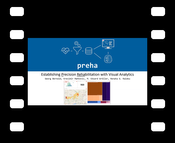Information
- Publication Type: Conference Paper
- Workgroup(s)/Project(s):
- Date: September 2019
- Lecturer: Renata Raidou
- Event: Eurographics Workshop on Visual Computing for Biology and Medicine (2019)
- DOI: 10.2312/vcbm.20191234
- Call for Papers: Call for Paper
- Booktitle: Eurographics Workshop on Visual Computing for Biology and Medicine (2019)
- Pages: 79 – 89
Abstract
This design study paper describes preha, a novel visual analytics application in the field of in-patient rehabilitation. We conducted extensive interviews with the intended users, i.e., engineers and clinical rehabilitation experts, to determine specific requirements of their analytical process.We identified nine tasks, for which suitable solutions have been designed and developed in the flexible environment of kibana. Our application is used to analyze existing rehabilitation data from a large cohort of 46,000 patients, and it is the first integrated solution of its kind. It incorporates functionalities for data preprocessing (profiling, wrangling and cleansing), storage, visualization, and predictive analysis on the basis of retrospective outcomes. A positive feedback from the first evaluation with domain experts indicates the usefulness of the newly proposed approach and represents a solid foundation for the introduction of visual analytics to the rehabilitation domain.Additional Files and Images
Weblinks
BibTeX
@inproceedings{raidou_2019_preha,
title = "preha: Establishing Precision Rehabilitation with Visual
Analytics",
author = "Georg Bernold and Kresimir Matkovic and Eduard Gr\"{o}ller
and Renata Raidou",
year = "2019",
abstract = "This design study paper describes preha, a novel visual
analytics application in the field of in-patient
rehabilitation. We conducted extensive interviews with the
intended users, i.e., engineers and clinical rehabilitation
experts, to determine specific requirements of their
analytical process.We identified nine tasks, for which
suitable solutions have been designed and developed in the
flexible environment of kibana. Our application is used to
analyze existing rehabilitation data from a large cohort of
46,000 patients, and it is the first integrated solution of
its kind. It incorporates functionalities for data
preprocessing (profiling, wrangling and cleansing), storage,
visualization, and predictive analysis on the basis of
retrospective outcomes. A positive feedback from the first
evaluation with domain experts indicates the usefulness of
the newly proposed approach and represents a solid
foundation for the introduction of visual analytics to the
rehabilitation domain.",
month = sep,
event = "Eurographics Workshop on Visual Computing for Biology and
Medicine (2019)",
doi = "10.2312/vcbm.20191234",
booktitle = "Eurographics Workshop on Visual Computing for Biology and
Medicine (2019)",
pages = "79--89",
URL = "https://www.cg.tuwien.ac.at/research/publications/2019/raidou_2019_preha/",
}



